Something I hear about more frequently nowadays is the concept of a “fixed value” for a given Standard set. In other words, once a Standard set is released and enough cards enter circulation, card prices adjust so that eventually the set’s overall value levels out at a specific number. Call it $120, $140, or the cost of redemption – call it whatever you’d like – the MTG finance community largely embraces the concept that a single card can “absorb” most of the value of a set and push down the value of the rest.
This sort of constraint is limited fairly narrowly to sets that are still in-print and/or redeemable from MTGO. There’s no similar limitation, for example, on the value of a Legacy and Modern deck.
Or is there?
This week I’m going to take a look at a few interesting trends across these eternal formats, and in turn develop some hypotheses surrounding the recent jump in many cards’ prices over the past few months. Ultimately I’ll answer the bottom line question: are reserve list and other older cards in a bubble?
The rest of this content is only visible to ProTrader members.
To learn how ProTrader can benefit YOU, click here to watch our short video.
The Modern Swoon?
This morning I was browsing values on some of the most popular cards in the Modern metagame. I immediately noticed that some of the hottest cards – some even popular in Legacy – have been dropping in price aggressively. Snapcaster Mage immediately comes to mind:
Then again, this card did just see a promotional printing. So let’s take a look at something also very popular in Modern that didn’t get reprinted in the past 6 months:
Perhaps Spellskite is suffering due to the banning of Splinter Twin in Modern. It’s price did peak in January – the same month that Splinter Twin’s banning was announced. Though it’s worth noting that this card is still a major staple of Modern.
And who could forget the savage beating Remand has taken lately due to its multiple reprints.
The charts above could lead one to believe the end is truly near for Modern. After all, these are significant drops! However, the interesting point I want to highlight is that while these Modern prices tumbled, a few other Modern cards have seen recent all-time highs! Consider, for example, the Modern Masters reprint Kitchen Finks:
Collected Company broke into Modern and has filled the void in Melira combo decks vacated by Birthing Pod’s banning. Therefore it’s no surprise to see this critical 3-drop storm to double digits despite the reprint.
Noble Hierarch is another card that was reprinted (this one far more recently) and yet has been overcoming the new supply and rising in value. The Modern Masters 2015 copies are even hitting all time highs as we speak.
And who could ignore one of the greatest Modern gainers in 2016, sideboard tech Stony Silence?
All of these price movements can be explained individually with a fundamental idea. Noble Hierarch is rising because it’s utility across multiple successful decks. Stony Silence has surged since Affinity has strengthened in the Modern metagame. You’ll also see easily explicable growth in cards like Inkmoth Nexus and Cavern of Souls. Equally, there’s an explanation for price drops in those like Inquisition of Kozilek and Gitaxian Probe. It almost seems like for every increase there’s an equal but opposite decrease.
Now let’s take a look at some Legacy charts.
Eternal Masters’ Force Majeure
When Eternal Masters hit hobby stop shelves worldwide, people had already anticipated what was to come – but only to a limited extent. What I mean is, players knew Legacy staple reserve list cards were bound to jump. This caused a small, temporary run on cards like Mox Diamond.
However the buyout was premature – after spiking to $120, the card immediately sold off again to reach a still-respectable plateau of $80. That is, until Eternal Masters had sufficient circulation. Now the card is butting up against that triple digit price point and it’s only a matter of time before it breaks through.
Perhaps the most noteworthy trend I’ve been following for Legacy staples – outside of buyouts and attempted price manipulation – is that of Dual Lands. Some of the more popular duals have been screaming higher in a somewhat under-the-radar manner.
When Underground Sea last hit $400, many in the MTG community screamed foul. And in fact, it did feel like that price target was forced a bit. But here we are again at $400 – with even higher buy list prices – and no one is blinking (or if they are, they aren’t vocal on social media). And it’s not just the most played duals that are moving. Check out one that I’ve had my eye on for weeks: Taiga.
Again we see a dual land peaking in 2014, selling off, and then returning to new highs. Could this be a tremendous Legacy Renaissance? Is the format surging in interest on the heels of Eternal Masters?
Possibly, but I need to now address the other side of this coin. As reserve list staples surge higher, many Legacy staples have sold off dramatically in the wake of Eternal Masters reprints. Karakas comes to mind first because the loss I’ve taken on my single copy hits closest to home. But I wanted the card for Legacy, so I knowingly signed up for the downside.
Despite being reprinted at mythic rare, the Eternal Masters reprint of Karakas really punished its price. Rares in the set were set back even further. Wasteland is one of the most played cards in Legacy, yet the card is notching two year lows on the recent reprinting.
Other cards that have suffered in price include Cabal Therapy, Jace, the Mind Sculptor, and Sensei’s Divining Top. Of course these are balanced out by surges in cards like Counterbalance, Surgical Extraction and Lion’s Eye Diamond. Some prices are dropping and others are on the rise.
Is there Incremental Money At Play?
Analyzing solely the data presented above, one may conclude that there’s no incremental value flowing into Magic. However I’d have to disagree with this conclusion, and the reason is related to cards I haven’t even mentioned yet: Vintage and Cube staples. No matter how much cheaper Mana Crypt gets due to its reprinting in Eternal Masters, it cannot overcome the fact that Library of Alexandria has gone from $300 to $800 this year. The Tabernacle at Pendrell Vale’s growth is likewise not explainable by the reprinting of Gamble. Even if a playset of Gamble was given away at every Legacy Grand Prix, they wouldn’t get cheap enough to counteract the $300+ gain in Tabernacle. Something more is clearly at play here.
My hypothesis is that there’s another driving force beyond just shifts in value from some cards to others within a metagame. For high end cards to continue their climb, there must be incremental money entering the game. And I can support this hypothesis with macroeconomics. Consider this: interest rates are near historic lows – in some cases outside the United States, treasury yields are negative! That means you can basically purchase a 10-year bond from the government (essentially giving them a loan) and you’d get less money back after ten years than what you provided. Yup. Negative interest. It’s a reality.
This phenomenon has driven investors to look for places to park money in order to earn some sort of stable return. Usually this void is filled by bonds and CD’s. But when you’re getting less than 1% interest on these products, it drives people to look elsewhere. Dividend paying stocks, such as Verizon, are hitting ten year highs as a result. People throw caution into the wind and ignore valuation – they see a juicy 4% dividend and they pile in.
As investors struggle to find safe yields, they’ve been amassing large cash balances. So to avoid sitting on piles of dead money, they begrudgingly put their precious resources to work in the stock market. This is one reason why the market is hitting all-time highs – there’s simply nowhere else to go for reliable returns in this low-rate environment.
Or is there? I’m going to go out on a limb here and suggest that at least a small amount of the most savvy MTG finance investors are looking at Magic as a superior alternate investment vehicle. It may sound unlikely, but in reality it doesn’t take much for such a consideration to become reality. People like Rudy from the Youtube channel Alpha Investments know that they can’t get better, safer returns from the market right now. I myself have recently added to my MTG portfolio, lifting my exposure to the collectible card game to a personal all-time high. In my brokerage account I’m unhappy with the funds sitting in cash earning 0.01% interest. So why add more when I see attractive opportunities in Magic? I’d wager Rudy and I aren’t the only ones thinking this way.
Wrapping It Up
What does it all mean? I’m drawing two conclusions here. First, I think the concept of Modern Masters and Eternal Masters sets reducing price of entry into eternal formats is a complete fallacy. All Modern Masters sets do is shift value from one basket of cards to another. For every Vendilion Clique and Dark Confidant there’s an Inquisition of Kozilek and Inkmoth Nexus. It’s impossible for Wizards of the Coast to support Modern’s growth as a format and simultaneous reprint cards fast enough to keep values manageable. And I’ll go as far as to say that Eternal Masters sets does more harm than good for the secondary market. All these sets will do is push down values of reprintable cards and concentrate value in high end reserve list staples – thus rewarding those with large reserve list collections and strengthening the 1% of MTG finance. In turn they can convert these profits into the very high end and drive prices to even higher levels.
The second conclusion I’m drawing is that I believe there is a growing number of MTG investors who recognize the opportunity in front of them. Anyone who deals with the stock market and the MTG market can see how investments in high end reserve list cards and strategic sealed booster boxes are highly attractive versus an inflated stock market. This is precisely why I personally decided to allocate new funds to my MTG account instead of my stock market account for the first time in three years. If I want a safe, steady return I frankly like Origins booster boxes more than an expensive Verizon stock at this point in time.
So where do we go from here? While I do see interest rates rebounding eventually, I’m not sure if that’ll drive prices of reserve list cards down at all. If I think about Magic from the long-term view perspective, the value of Power, duals, and other high end reserve list cards will be proportional to the longevity of the game. If Magic is around for another 23 years, I shudder to imagine what a Black Lotus could sell for at that point in time. Considering a Honus Wagner baseball card sold for over $2 Million back in 2012, I’d say Magic cards have plenty of runway. While the Honus Wagner card is far older and rarer than Black Lotus, there is one thing the Lotus has going for it. People can’t enjoy playing a fun game with their baseball card…
…
Sig’s Quick Hits
- I was not expecting this one. While Star City Games has a few dozen Underground Sea and Volcanic Island in stock, they have only 20 Revised copies of Scrubland available – none are Near Mint. This goes back to my earlier point that all dual lands are on the rise now, and I suspect we haven’t seen their peaks yet.
- A few weeks ago I picked up a single SP copy of Nether Void as a modest bet that the reserve list card would spike in price. One month later, I firmly believe we’re on the doorstep of such a jump. Star City Games had a few copies in stock as recently as a week ago, but now they’re completely sold out. TCG Player is also down to just a few copies. Star City will inevitably raise their price now, and the momentum won’t stop. DISCLAIMER: I have my single copy listed on eBay at the inflated price of $350 in case there is a spike.
- Force of Will is still out of stock at Star City Games. Their Alliances copies are listed at $110 but there are none in stock and I suspect these will get re-listed $10-$15 higher. This is 100% definitely the Tarmogoyf of the Eternal Masters set, rising in price despite the reprint. It’s fascinating to watch Legacy cards react in price consistently with Modern cards during Modern Masters reprint years, only with more magnitude due to rarity and age.


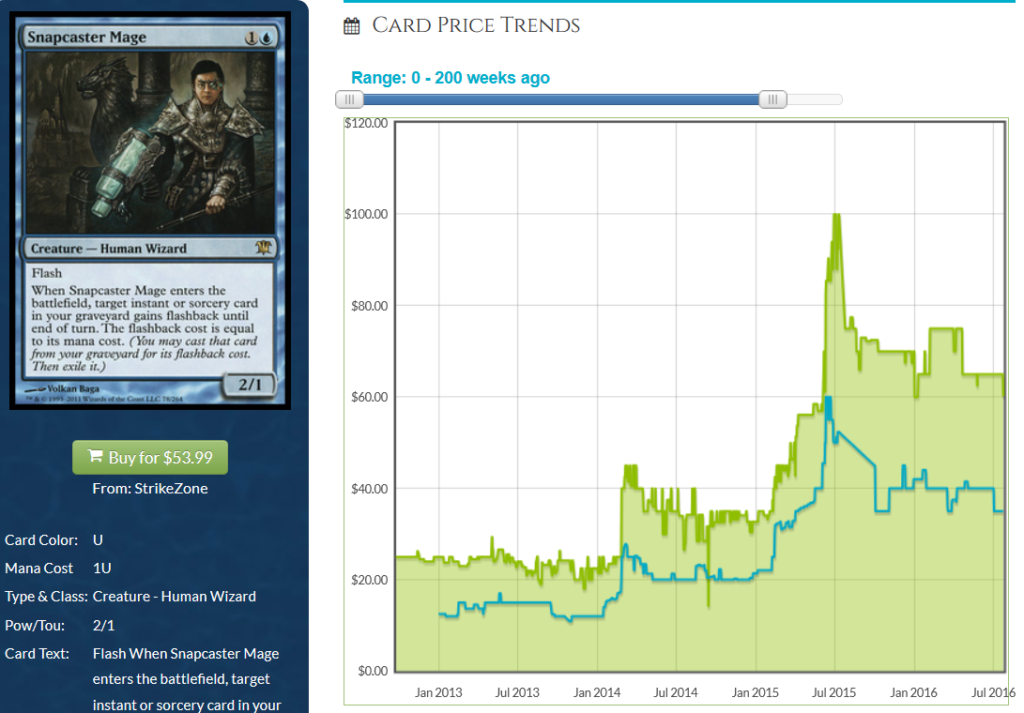
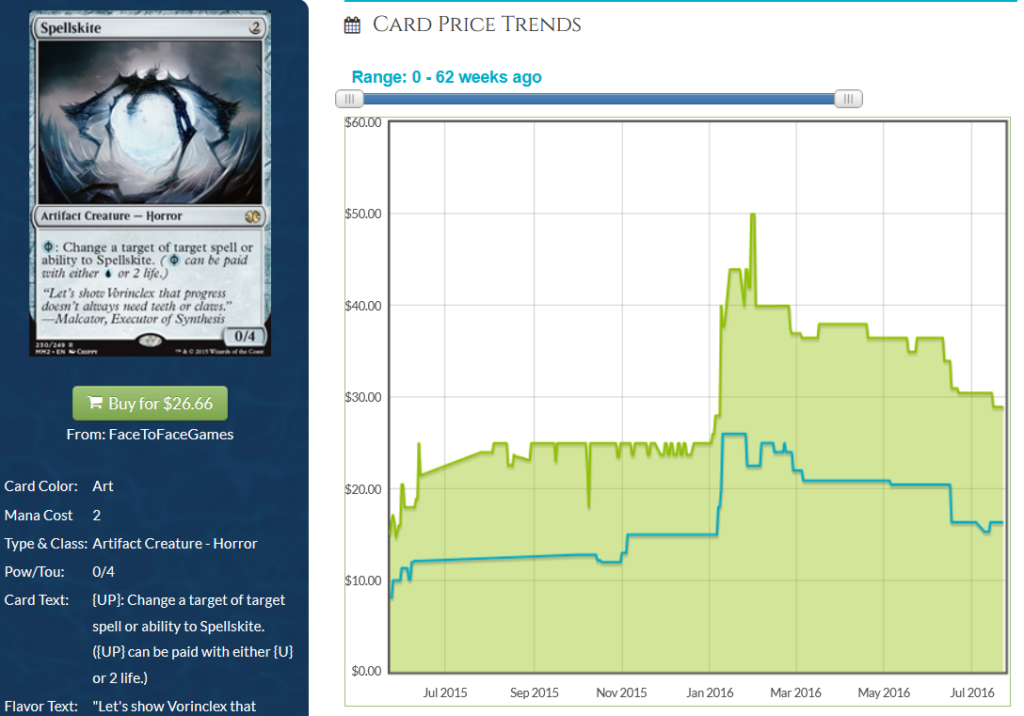
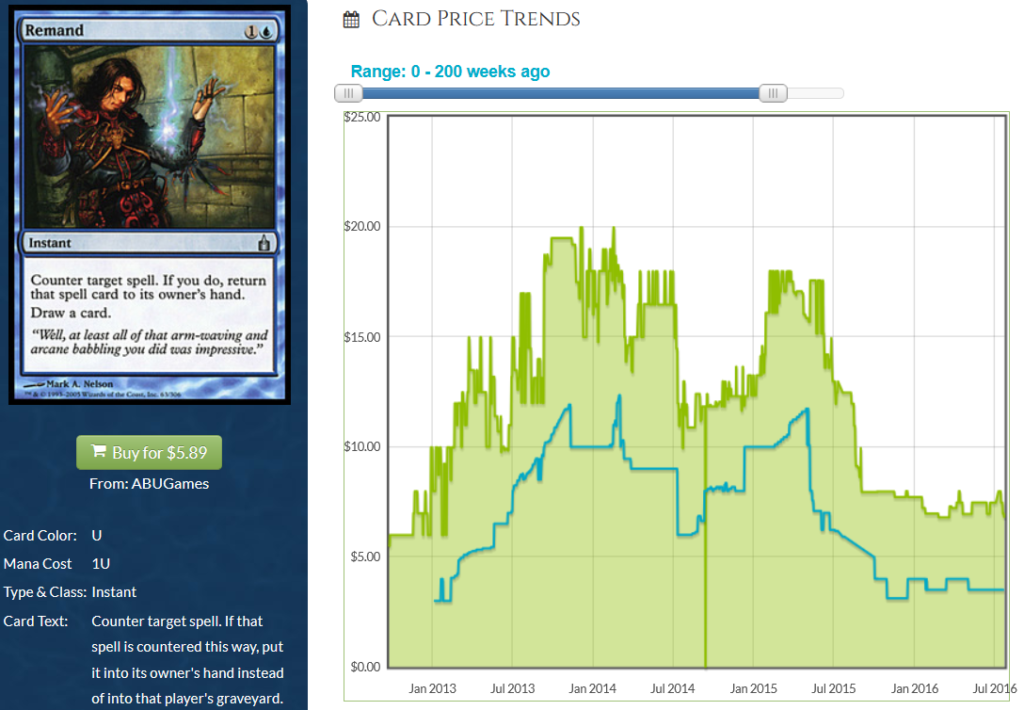
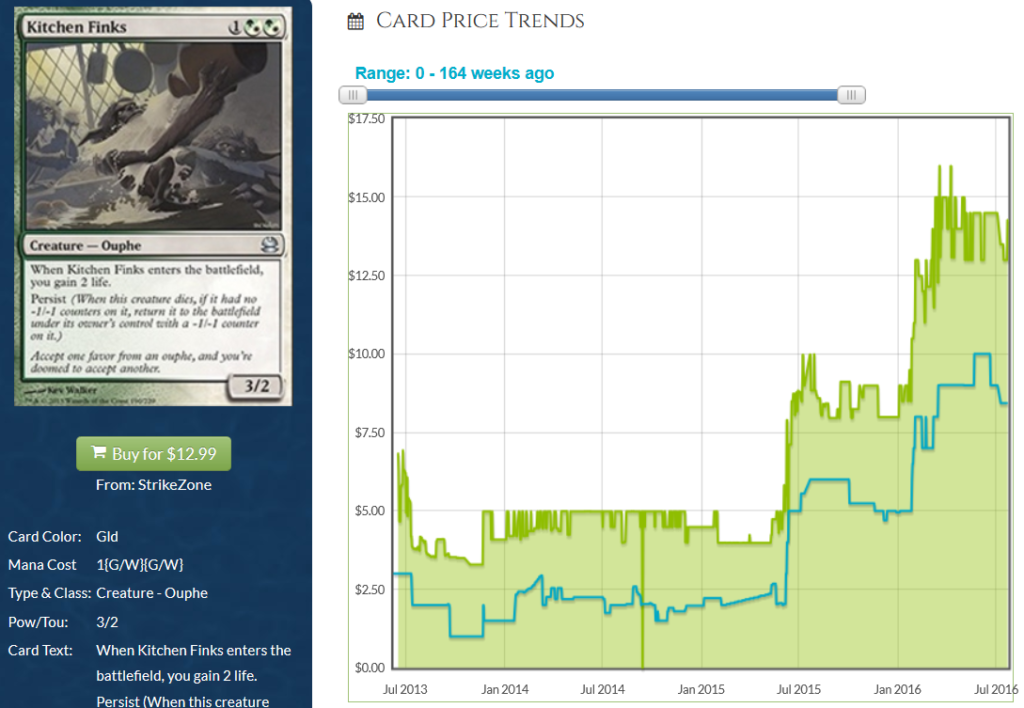
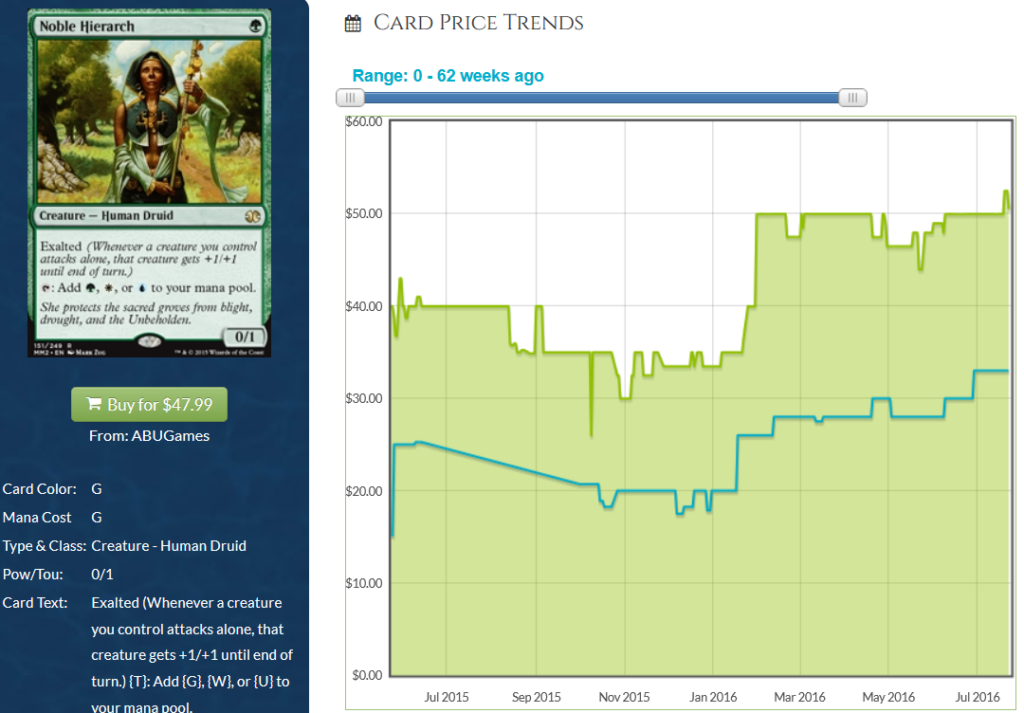
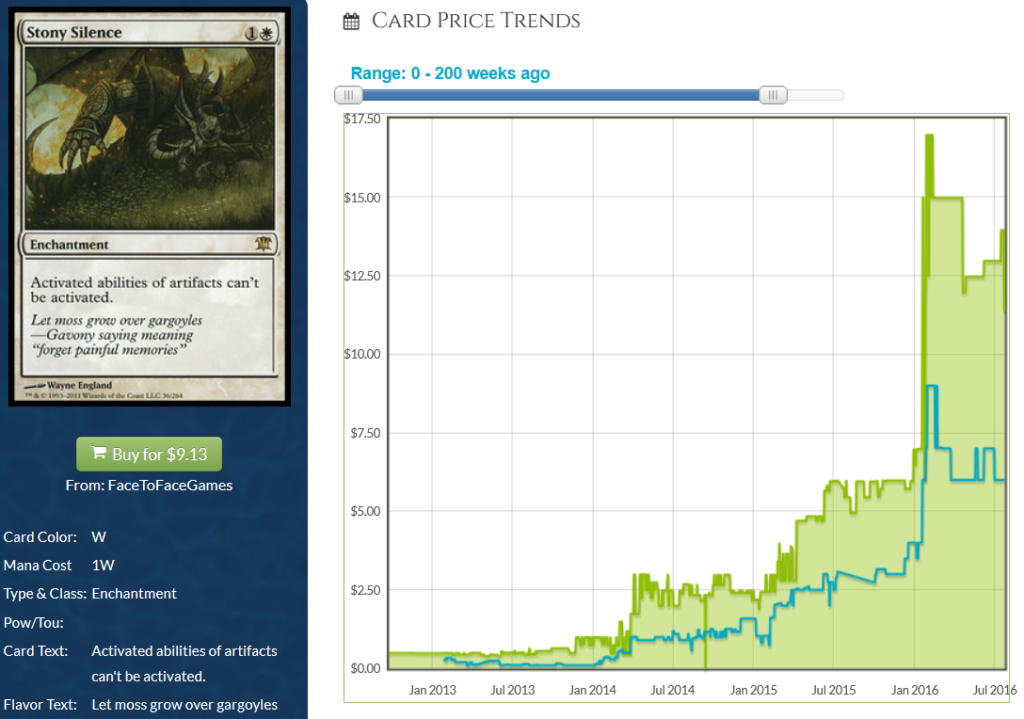
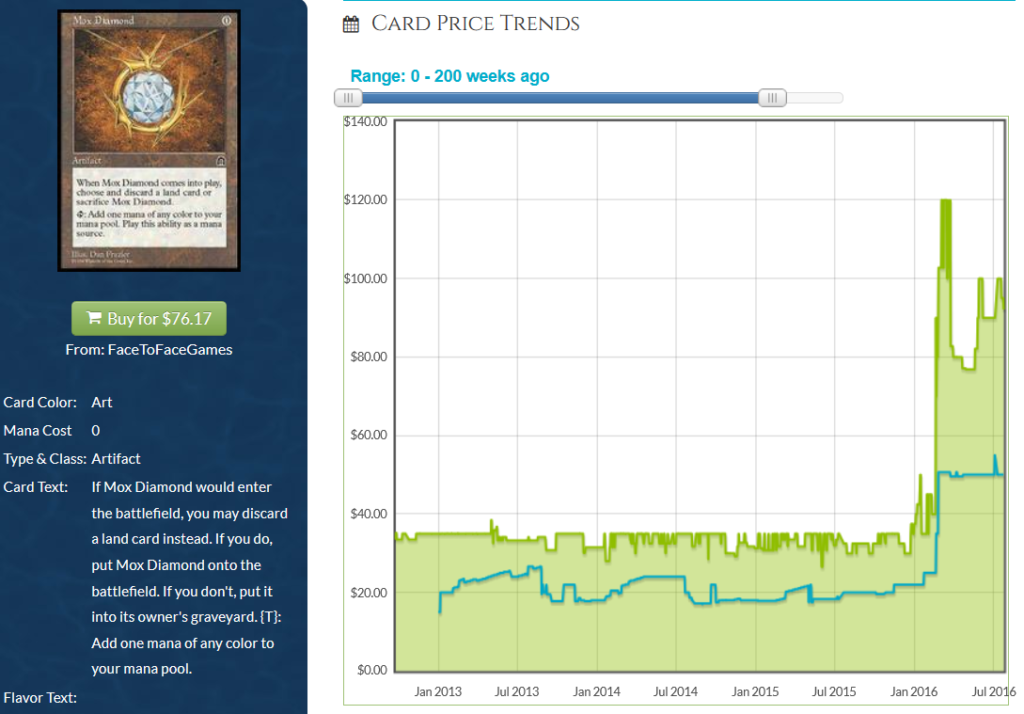
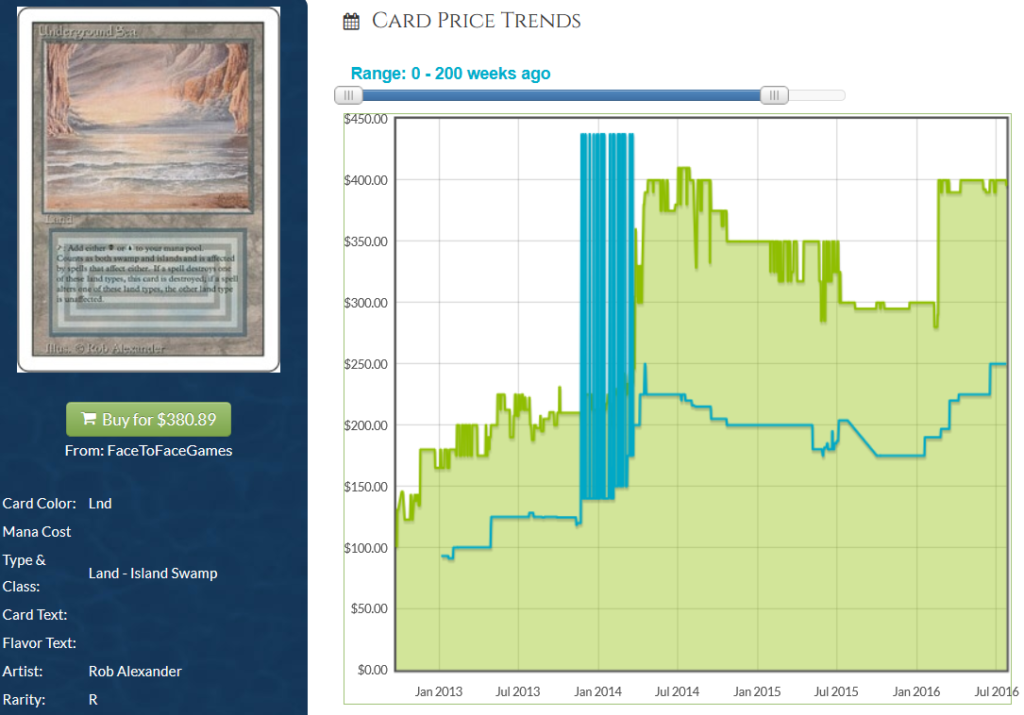
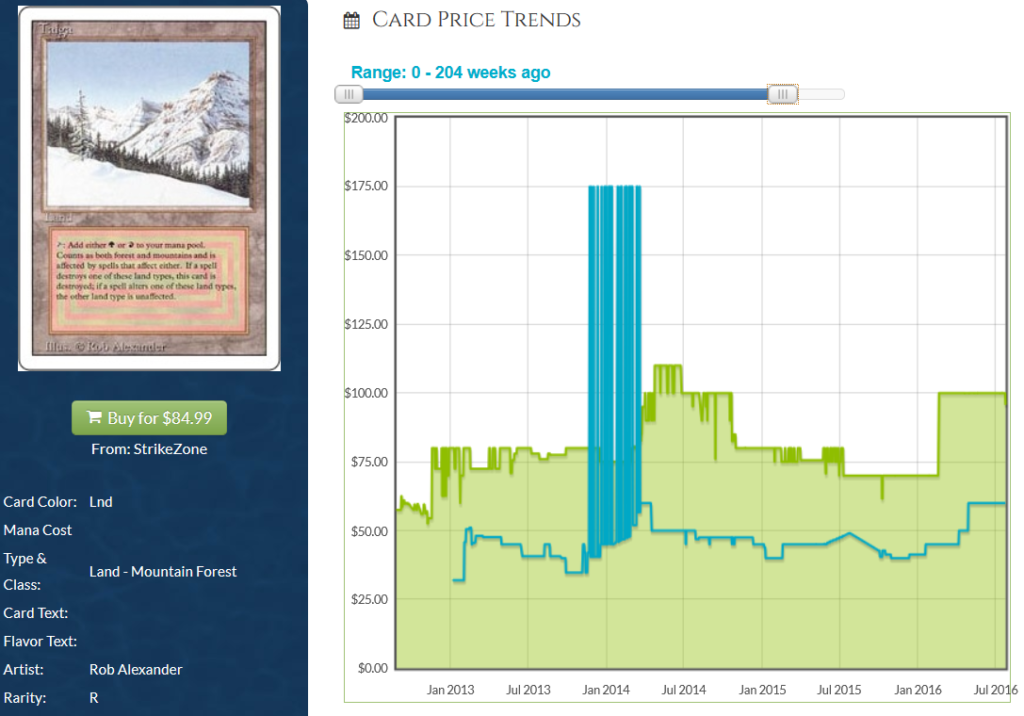
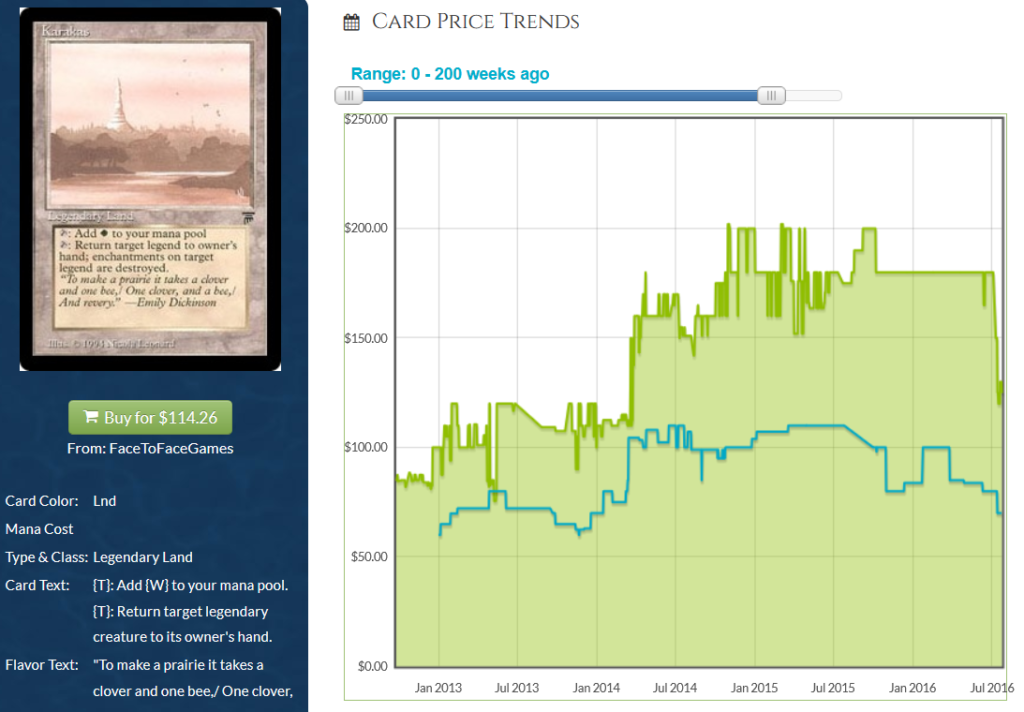
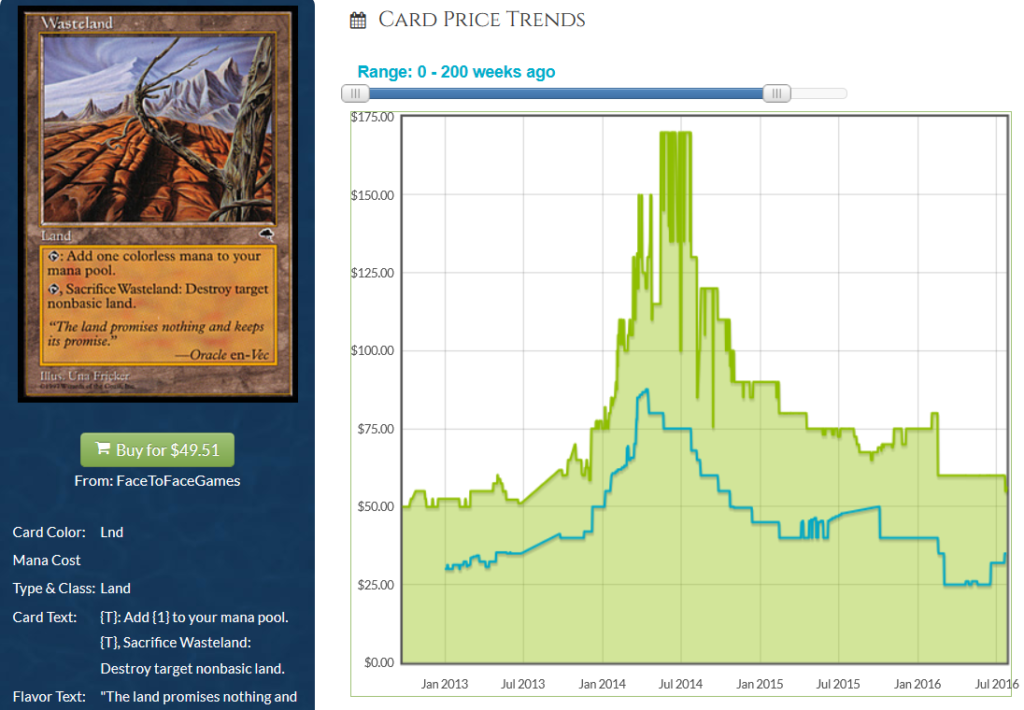
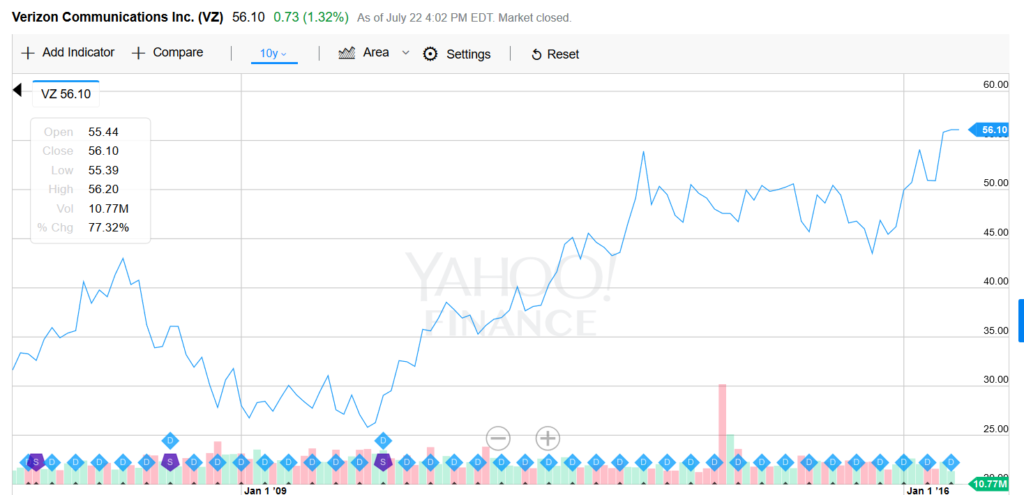
Investing in stocks/bonds/shorts is a massive risk. All of those things rely on USD maintaining value. Investing in cardboard is somewhat risky too, due to risk of robbery, fire, flood etc… My preference is to diversify between magic, silver, guns, ammunition, seeds, water filtration, water storage, security for all the above. Don’t be a victim of a complete economic collapse, tyranical taxation, or natural disaster.
T,
While I can’t argue that you’re approach is diverse and immune to a World War III, I have to imagine it’s a bit too far on the pessimistic spectrum for me. I don’t necessarily define all stocks as “massive risk” – in fact, many diversified index funds have performed exceptionally well over long time periods. Unless you think there’s going to be a major disaster, the stock market will generally do well.
That being said, I encourage all serious investors to diversify into alternative vehicles such as magic cards and coinage.
Thanks for sharing your thoughts!
Sig
Sig, I’m not sure what to comment on cause u touch on so much :p First and most UNimportantly Gitaxian Probe isn’t dropping in price. The foils did but the regular version is a solid $4+; and the foils likely dropped when the delve bombs Cruise and Dig were banned out of Legacy. Minor point…
Second, i thought you were going to talk about the fixed value of a Standard set but you didn’t. Interesting curve ball but I’ve always wondered why there’s only a certain amount of value assigned to a Standard Legal Set. I assume it has to do with MSRP and now set redemption, but when a set sucks why isn’t the “value” $50 when for a great set (like Oath) it could be $120 ?? Like I’ve felt Gideon has probably been closer to a $40 rare but due to the Expeditions and more importantly the sheer volume of BFZ opened to obtain Expeditions his price is a bit depressed which makes sense. But I feel like the cards in Oath are severely depressed because there’s so many good cards but they all have to share value from the same “fixed value” ARTIFICIALLY applied to a Standard set. Is this fixed value artificially applied or is there a solid reason for the fixed value?
That’s my main question. Additionally though, with the decline in some of the card prices you mentioned like Snapcaster and Spellskite I feel like their spikes coincided with an enormous Modern GP. Not sure if you had already done analysis on that. And a huge thanks for pointing out that dual lands are going up in value, makes me feel a little better.
The fixed value of standard sets isn’t artificial. It’s the balancing point between the value of the cards in that set and the price at which stores and big wholesalers can purchase sealed product of that set. Because the supply of a set still in standard is unlimited (wizards keeps printing boosters as long as stores are ordering more) any jump in the total value of that set is eventually brought back down because stores and individuals will start opening boxes knowing they are statistically favored to be able to make money reselling the singles. They do this until the supply of those singles goes up, thus bringing the value down far enough that it is no longer a safe bet to open booster boxes for profit.
Does Wizards look at the “value” of a Standard set on some website to determine if they need to print more? I understand what you are saying, but most of the time writers and prospectors talk about the supply of a set based on how much and how long a set is drafted. Will Wizards just print extra boxes if there isn’t demand? Like DTK wasn’t drafted much but I remember hearing for a while it was still great value to crack DTK packs. Did/can Wizards just decide to print more product (even if no one is drafting or opening it)? Origins Jace was roughly $100 at one point, I don’t remember hearing anyone buying cases just to crack open a Jace even though there was more than enough value there, I kept hearing Origins was in low supply and that’s one reason he was so expensive.
You’re right – wizards isn’t paying attention to the overall set value and printing more product to try to lower that number, I mean only that stores (who also sell singles) will order more boxes from wizards and other middle-men distributors and then crack open some of those boxes in order to have the singles from the set available for people ordering those cards from them. But if there aren’t enough high-value singles in the set, they will stop cracking whole boxes to find them and only fulfill singles orders by buying those singles directly through their buylists (raising the buylist price till enough players send them the singles they need). Remember that even if a card in a set – like Jace, vrynn’s prodigy – explodes in value, there still have to be enough other valuable cards from origins such that the total value of the set is high enough to make it worth opening (on average) 4 to 6 boxes to find that one Jace. Jace was worth the value of an entire box (at wholesale cost anyway) at his peak, but it wouldn’t be worth opening 4 to 6 boxes to find him if a large number of other cards aren’t valuable enough to pick up the rest of the cost. In some sets they are, in some they aren’t.
How much a set is drafted is a different, though contributing, issue. Ton’s of players opening packs and occasional Jaces because they think origins is a fun draft environment, will add to jace’s supply and lower his value. But origins – as with most core sets – was aimed at newer players and was not considered a great draft environment, so fewer packs are opened. But a poor draft environment doesn’t mean jace isn’t really good in standard and other formats, so those jaces still need to get opened somehow. If the overall value of origins as a set is high enough, then stores (and some individuals) will answer that need by cracking boxes. If the value of the whole set is too low (regardless of Jace’s value) then cracking boxes is not the financially sound avenue, and stores just raise their buylist prices till players start sending them in.
My knowledge of these issues is very imperfect, but I’ve read a number of long articles about this stuff and am condensing it here. I encourage you to seek out more detailed explanations by the trained professionals. (SaffronOlive on mtggoldfish in addition to the many fine writers on this site.)
Thanks for your input and posting tombiby. I have a feeling stores and players did start cracking Origins boxes to find Jace and other cards. There is/was a ton of value in the set and a bunch of Eternal playables. Now I just wonder if other cards will go up as the decline of Jace should free up space under the set’s fixed value.
tombiby hit this on the head. I should have read further before commenting because he was much more detailed than I could have been. 🙂
Spencer,
I think the major factor for standard set value caps is related to two things:
1) Redemption
2) Booster box prices
i.e. When a set becomes more expensive due to price increases of cards within that set, more stores/people crack boxes and redeem sets on MTGO – thereby increasing supply and dropping price. That $120-$140 seems to be the “sweet spot” equilibrium. But I’m no Standard expert so I’m likely oversimplifying this a bit.
Thanks for commenting!
Sig
Oh, one positive story for you:
I had bought SDCC 2015 (flip) Planeswalker sets for just over $200 last year…$50 each for black on black flip walkers seemed like insane value. Recently I had to sell some off due to identity theft, but I was able to out Jace at $125, Lili at $60, Nissa $40, Gideon $30-35, and Chandra $27.50. These were buylist prices to 2 major stores!!! Not even online sales. So in 1 year I made $60 on my SDCC box sets and that was just selling to buy lists. I don’t know if you feel there is similar value in this years Zombie walkers, I personally do NOT and won’t buy a single box set, but I wanted to share one positive spec experience with you. Sometimes we are right about things 😀
That’s pretty solid, nice move!
Investing in Magic makes sense if you are very informed and believe your investment will perform, and either lack information about similar investment opportunities or have analyzed them all and decided you like your odds here better. If your’e a long-time player or dealer, I could see this calculation bearing out. I doubt we’re seeing any “real” money investors making this decision, though.
Investing in a collectible card game is a high-risk, high-reward investment. This may have been more salient back pre-2000, but it remains true today. (How’s that investment in Vampire: The Masquerade CCG going for ya).
Yes, you can argue that if you parked X dollars in Magic cards in 1998, you’d have beaten the stock market for the same period of time. That’s the wrong analogy, though. Instead, you need to look at specific stocks. Buying M:TG as an investment vehicle is like picking a particular start-up company and investing because you think it’s poised for growth. You could easily lose everything, or you could get hundreds of times your investment if the company goes big.
On top of that, as expensive as Magic is, the big players toss around tens of thousands of dollars on speculation. That’s on the high side. Real World Money looks for investments on a much larger scale. If you wanted to spent $2.5 million dollars, for example, I don’t think you could feasibly even spend that much making wise purchases of Magic cards.
So, I doubt we’ll see anyone making the decision to invest in MT:G instead of, say, StartUp Company X, except from people who are already deeply enmeshed in MT:G culture, community, or finance.
Great counter-points. It’s easy to look back and say “see, MTG outperformed the stock market” because the comparison isn’t fair. But looking forward, I’m not sure if all Magic investments are as high risk as you allude. For example, buying into a high-grade Alpha rares could yield safe and steady returns as collectors take copies out of circulation and drive down supply. Investing in Origins Booster Boxes will likely yield slow and steady growth. To me, the only major risk to these types of MTG investments is related to Magic itself. But as long as Magic remains healthy, these investments should pay out.
I just want to point out that there are multiple people with 7 figures in MTG. Rudy from Alpha Investments is one of them, and I know there’s a guy in the Facebook High End group currently selling the second best graded Alpha set in existence for over $1 Million. The number of millionaire MTG investors is likely to increase – not decrease – as the game ages.
Appreciate the engaging debate 🙂
Sig
Sig,
If individuals are starting to invest, do you think of this as hot money that will leave as soon as any other opportunity with less risk appears? Even a small amount of hot money, it seems, would wreak havoc on our little market. What do you think?
rblackman,
Good question. It’s possible. Once interest rates return to normalcy, I expect stocks like Verizon to sell off because Bonds would offer attractive yields again with much less risk. Could that same phenomenon also move wealthy investors out of MTG? I guess it’s a corollary I have to accept or it undermines my entire thesis.
The only counterpoint would be that MTG investors may be a bit emotionally attached to their MTG investments, making the cards a little less likely to enter the market so quickly should the economy shift course.
What do you think about this?
Sig